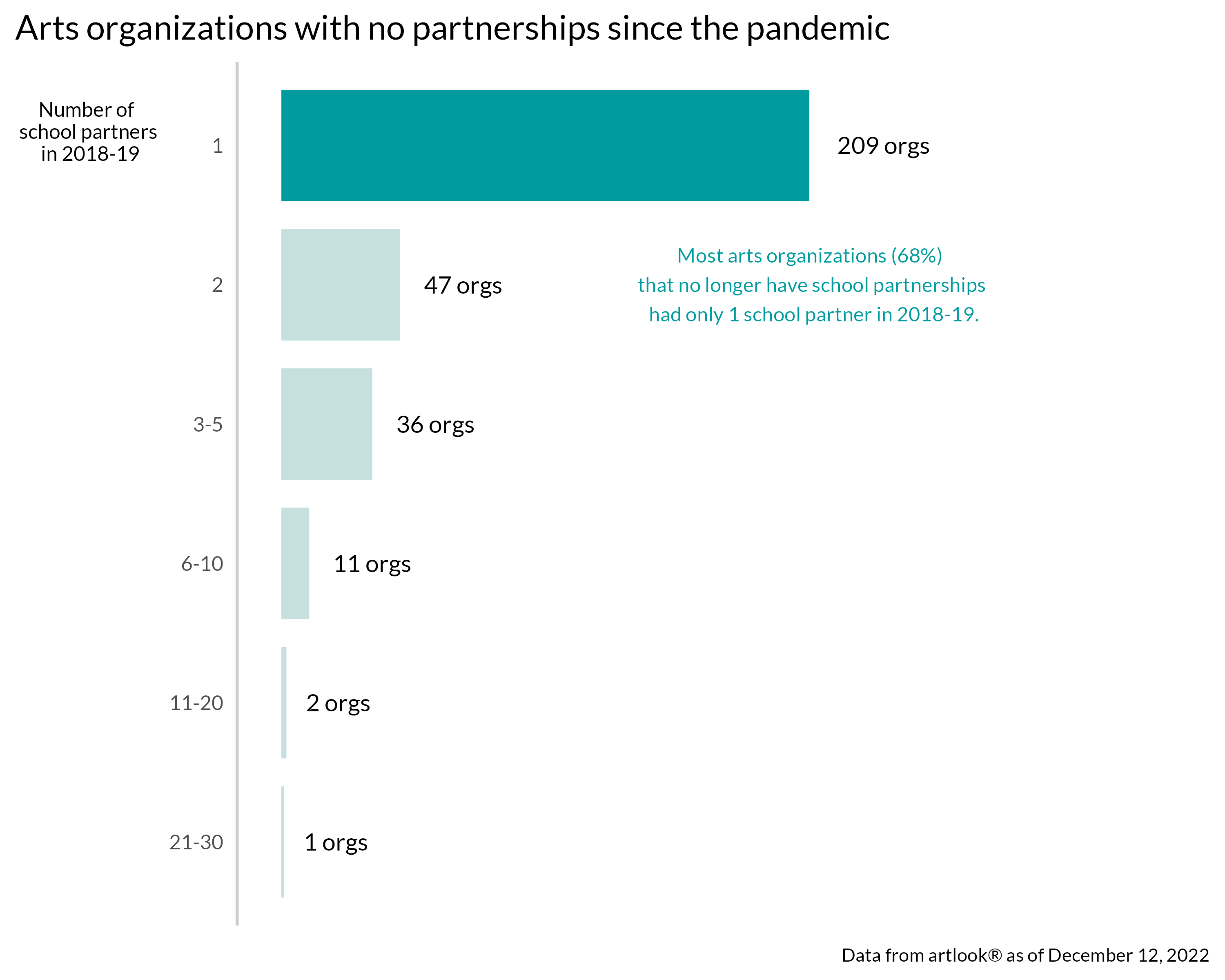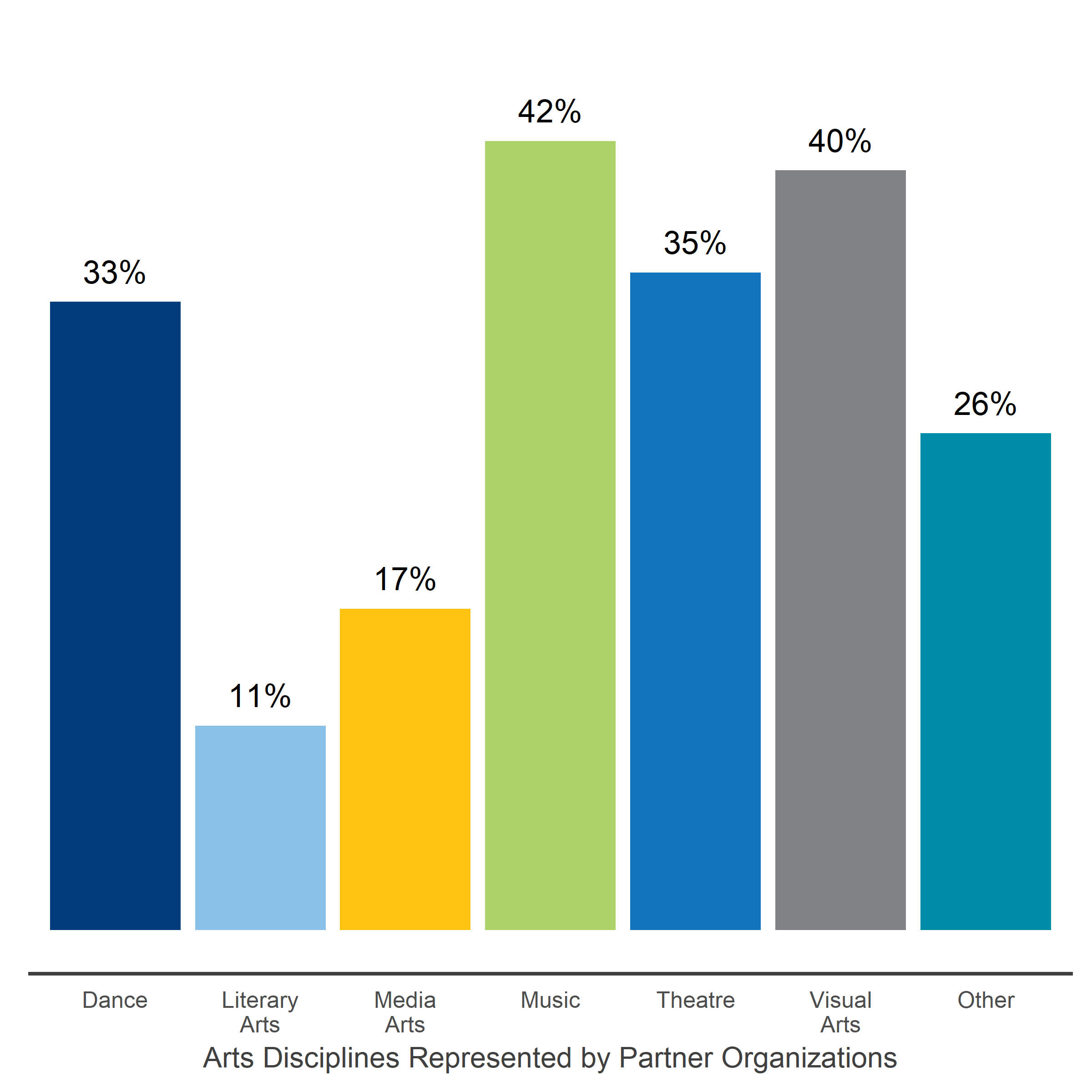Data Snapshot: Arts Partnerships Before & After the Pandemic
Introduction
Arts partnerships have long been crucial to the arts learning experiences of Chicago Public School (CPS) students. Partnerships between schools and arts organizations augment classroom instruction and add arts depth and breadth to the student experience. Prior to the COVID-19 pandemic, in school year 2017-18, there was 33% growth in the number of active arts partners working in CPS schools* – a total of 575 arts organizations. In the 2019-2020 school year, the pandemic abruptly shut down schools in mid-March; however, there were still 559 arts organizations that partnered with CPS that year. By the next school year, this number dropped sharply to 295, a 47% decrease**.
While arts sector recovery efforts have been encouraging as we return to pre-pandemic offerings, challenges still reverberate. Building back partnerships to pre-pandemic levels has continued to be a slow and difficult process. Now that it has been a few years since the onset of the pandemic, we seek to understand some of the numbers and trends that we see in arts partnerships.
Here are the questions we’re exploring in this Data Snapshot:
- What were the challenges faced by arts partners during the COVID-19 pandemic school years?
- What were the common characteristics amongst arts organizations that had school partners in 2018-19 but no longer in 2020-21? Did they serve fewer or more schools? What artistic disciplines did they provide ?
- Who were the arts organizations that had school partnerships in 2018-19 but no longer in 2020-21?
- How can we use this data to build back partnership numbers?
In mid-2020, in response to the pandemic and the ongoing violence against Black communities, the ArtsEd Response Collective (ARC) was formed to understand the challenges facing the arts education sector and provide recommendations for navigating this new landscape. Ingenuity convened hundreds of stakeholders including arts partners, CPS teachers, students, principals, Network Chiefs, and philanthropic leaders. The ARC process shed light on a number of challenges faced by the sector, including transitioning arts programs to remote formats, navigating CPS vendor processes, student engagement and attendance, decreased revenue streams for arts organizations, and staffing capacity and turnover at both organizations and schools.
Principals were worried about losing partnerships for their students, expressing that it would be “a loss not to have these opportunities”***. Partnerships between schools and arts organizations take years of time and energy to cultivate, and teachers also felt strongly about the value of partnerships****.
“In March of 2020, we literally had to shut down,” shared Audrey Frost, Executive Director of Shift:Englewood. “The schools closed, we got to go in one last time with our students and sent them all home with their instruments. We attempted to continue in an online setting, which is extremely difficult on multiple levels.”
Parker Nelson, Education Programming Coordinator at Fifth House Ensemble, also reflected on the challenges that Fifth House Ensemble faced during the pandemic with staff turnover. “Different members left, for a variety of reasons…When we brought in new people, there was a little bit of a void of where the training was coming from,” shared Nelson. “We had made models for how to train that stuff, but with so much of it happening and such in a different way than it used to happen, it was really hard to train the people that were coming in on different aspects.”
* 2017-18 State of the Arts Report
** 2020-21 State of the Arts Report
*** ArtsEd Response Collective (ARC) Final Report
**** ArtsEd Response Collective (ARC) Final Report
For arts partners that were no longer active in CPS schools in school year 2020-21, how many school partners did they have in 2018-19?
Of the reporting organizations on artlook® that served schools in 2018-19, 306 no longer had any school partnerships at all in 2020-21. Of these organizations, 209 – or 68% – only had one school partner in 2018-19. By and large, organizations that served one school were amongst those that no longer had partnerships in 2020-21.

For all arts partners in 2018-19, and based on the number of schools served, what percentage of them still had partnerships in 2020-21?
The prior visualization included only data from organizations that no longer had partnerships in 2020-21. In contrast, the table below includes all arts partner organizations from 2018-19 – including those that had no partnerships. Bolstering our conclusions in the prior section, we see a clear and similar pattern in our data – partners that served more schools were significantly more likely to still have partnerships in 2020-21.
| Number of school partners in 2018-19: | Percentage of Arts Partners that had partnerships in 2020-21: |
| 1 | 24% |
| 2 | 41% |
| 3-5 | 58% |
| 6-10 | 79% |
| 11-20 | 94% |
| 21-30 | 94% |
| 30+ | 100% |
As a most extreme example, all organizations that served more than thirty schools in 2018-19 also had partnerships in 2020-21. Meanwhile, only 24% of arts organizations that served one school in 2018-19 remained active in 2020-21. There is a strong link between the number of partners an organization has and the likelihood of it partnering with schools in 2020-21. In rebuilding the number of arts partnerships for the current and future school years, organizations with few school partners should be prioritized as they were disproportionately impacted.
For arts partners that were no longer active in CPS schools in 2020-21, what artistic disciplines did they represent?
More than 40% of arts organizations that no longer had partnerships in 2020-21 were Music or Visual Arts. Below, we see that the representation of arts disciplines is largely similar to the distribution of arts partners across the sector.

Interestingly, of the organizations that reported their data, fewer Literary Arts organizations became inactive. What does this mean? One theory is that long term resilience for arts organizations depends on how easily they were able to transition their programs to a virtual format; a transition that might have been easier for Literary Arts organizations than, say, music-focused organizations.
In a session from June 2020 for the ArtsEd Response Collective^, students shared that the access to materials and resources, such as instruments and a practice space, presented a challenge with the shift to remote learning. We also heard that it was particularly difficult for arts partners and teachers alike to cultivate a sense of ensemble in an online setting.
Who were the arts partners that were active in CPS schools in 2018-19 but no longer in 2020-21?
See which arts partner organizations no longer had arts partnerships in 2020-21. Zoom into specific areas of interest and click to see statistics for the organization, including the number of school partnerships they had since 2018-19.
To be clear, this map doesn’t assume that these arts organizations closed; rather, they no longer had arts partnerships in 2020-21. We also looked at whether these organizations are BIPOC, but due to limited data, we cannot make any definitive conclusions. For more information about BIPOC arts organizations, read a prior Data Snapshot about BIPOC representation in arts partners across Chicago.
If your organization’s data is not captured correctly in the visualizations above, it will be once you update your artlook® profile. Get started by clicking here.
Conclusion
While there have been encouraging rebounds in the number of arts partnerships in CPS, opportunities for students are still far below pre-pandemic levels. What can we do to accelerate regrowth of arts partnerships in CPS?
Funders:
For your grantees, explore ways that you can support rebuilding partnerships. Use the visualizations above and on artlook® to explore data about your grantees. Encourage grantees to update and complete their artlook profiles.
Share these data points and findings so that we can bring attention to these numbers and continued challenges. Arts partnerships are essential for high-quality arts learning at schools; more partnerships between schools and arts organizations means more support for the arts in schools and stronger funding and resources for teaching artists and arts organizations.
Arts Partners:
artlook®, a platform built to connect arts partners and arts educators, gives you the information you need to make strategic decisions about expanding the arts in Chicago Public Schools.
Update and complete your information on artlook® so that schools can reach out to you and form partnerships. With these data points, we can continue to report out information about partnerships across the sector.
Keeping your artlook® profile up to date allows you to engage with arts educators on a deeper level, including by taking part in networking events like the annual Summit and applying for funding to create partnerships that advance access to the arts in Chicago Public Schools.
Ingenuity is focused on rebuilding partnerships in the current school year and helping partnership numbers rise. While these figures and analyses reflect some of the stark realities of the pandemic, our preliminary analyses on the 2021-22 school year show an upwards tick of many of these metrics. We are hopeful in seeing the sector reshape and rebuild in this new landscape.
Acknowledgements
Thank you to our ArtsEd Leadership Advisory Committee (ALAC) for reviewing these underlying data and sharing feedback with Ingenuity. While there are still many questions to explore, their input has been invaluable.
ALAC Panel Members: 2022-23
| Katia Borione Arts & Culture Community Partnership Specialist Communities In Schools of Chicago |
Eboné Harden Director of Education Hubbard Street Dance Chicago |
| Courtney Bradshaw Executive Director Youth Civic Light Opera of Chicago |
Jennifer Hodges Vice President Whole Child Initiative, KIPP Chicago |
| Priscilla Chico Visual Arts Teacher George M Pullman ES |
Michael Manson Founder and Executive Director Musical Arts Institute |
| Ilesa Duncan Artistic Director Lifeline Theatre |
David Mathews Creative Writing Instructor & Administrative Assistant to Artistic Director Chicago High School for the Arts (ChiArts) |
| Ladonna Freidheim Founder & President ReinventAbility |
Leo Park Music Teacher CPS – Northside College Prep |
| Susan Friel Programs Coordinator City of Chicago’s DCASE |
Elizabeth Sampson Executive Director Chicago Poetry Center |
| Christopher Graves Principal CPS-LaSalle Language Academy |
Naomi Sheridan Senior Director of Development The Chicago Center for Arts and Technology |
| Krystal Grover-Webb Visual Arts Teacher & Arts Liaison CPS-Amelia Earhart Elementary School |
Jonathan VanderBrug Deputy Director Arts Alliance Illinois |
| Samina Hadi-Tabassum Associate Clinical Professor, Director of Child Development Program; Director of School & Community Partnerships Erikson Institute |
Kate Walsh School Partnerships Programs Manager Old Town School of Folk Music |
| Justine Haka Poetry Manager Poetry Foundation |
Antoinette Wright Executive Director National Museum of Gospel Music & Camp of Dreams |
Contact Us
Interested in learning more about what you read above or Ingenuity? Don't hesitate to reach out!
Contact Us